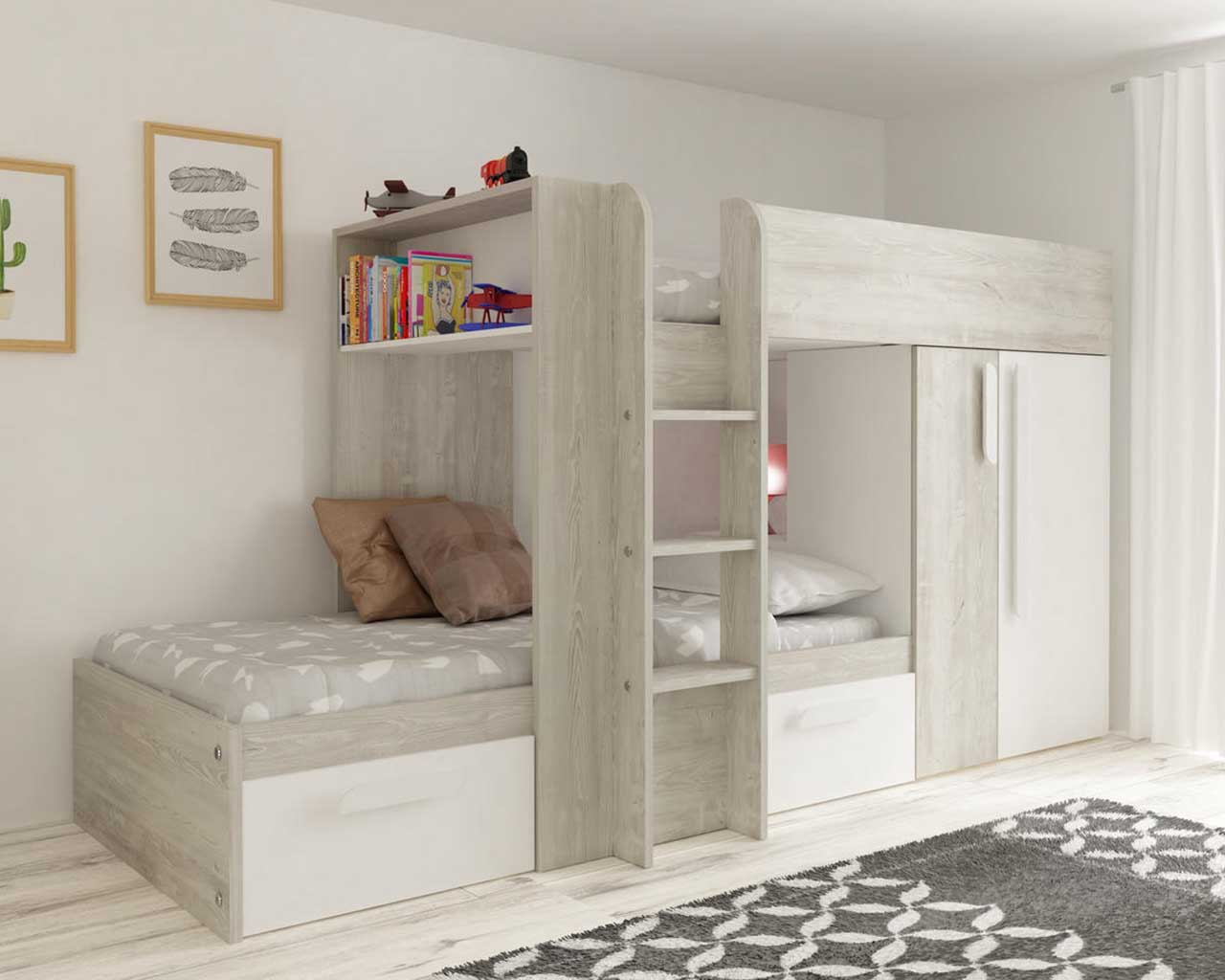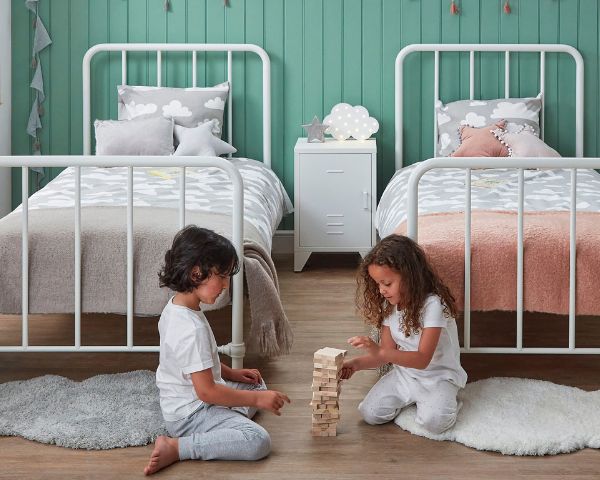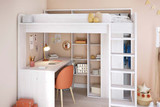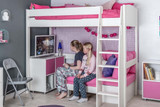Room Sharing Tips & Advice for Blended Families
In today's modern world, families come in all shapes and sizes, and the traditional image of the nuclear family has evolved into a beautiful mosaic of diversity. Blended families, formed through remarriage or re-partnering, are an ever-increasing reality, and with them comes a unique set of challenges and rewards.
Among these challenges is the delicate matter of arranging living spaces for the children involved. While some may have the luxury of separate bedrooms, many blended families find themselves contemplating the idea of children sharing a bedroom. There is of course more to room sharing than simply kitting out the kids room with new bunk beds.
At first glance, the prospect of siblings or step-siblings sharing a living space might raise a few eyebrows or concerns. If you’re considering changing your living arrangements in this way, you may be worried about potential conflicts. There’s also the need for individual privacy and how to navigate the different personalities and preferences of each child. However, as with any aspect of blended family life, the key lies in fostering open communication, understanding, and a nurturing environment where every child feels valued and cherished.
In this article, we explore the benefits and challenges of children sharing a bedroom in blended families. From cultivating strong sibling bonds and promoting empathy to instilling a sense of togetherness and resilience, shared bedrooms can become a breeding ground for life lessons that extend far beyond the walls of a home. Additionally, we'll delve into practical tips and creative ideas on how to create personalised spaces that cater to each child's needs and interests.
While the road to blending families may not always be smooth, the decision to have children share a bedroom can be a transformative experience that strengthens the familial bond. So, whether you're considering this arrangement or seeking ways to make the most of your current living situation, we’ll provide you with insights, inspiration, kids beds ideas, and encouragement as you navigate the joys and challenges of raising a blended family.
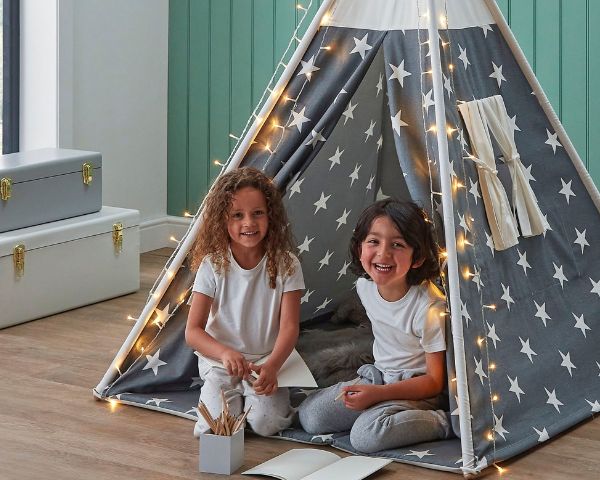
Reasons for Kids from Blended Families Sharing a Room
Children from different families might find themselves sharing a room due to various life circumstances. Some common scenarios include the remarriage or re-partnering of single parents, creating blended families with step-siblings.
Economic factors might also play a role, where families facing financial challenges choose to share living spaces to make ends meet.
Additionally, in cases of adoption or foster care, children from diverse backgrounds may be brought together under one roof, fostering a sense of unity and belonging through the shared experience of living together. In such situations, children sharing a room can build lasting bonds, promote understanding, and create a supportive family environment.
Difficulties of Kids in Blended Families Sharing a Room:
Privacy and Personal Space:
Children, especially teenagers, may struggle with the idea of sharing their personal space with a new sibling. They might find it challenging to adjust to the presence of someone unfamiliar in a space that’s always been their own.
Privacy is a fundamental need for individuals, regardless of age. It’s natural to feel a loss of personal space and struggle with the idea of having limited privacy in their living quarters. This is particularly true for teenagers and pre-teens, who are at an age where they begin to seek more independence and personal boundaries.
Here are a few ideas to help you overcome these difficulties around privacy:
- Room Dividers: Room dividers or curtains can create separate "zones" within the shared bedroom. This allows each child to have their designated area and adds a sense of personal space while still maintaining the idea of sharing a room. Younger children might be better suited to two single beds, but older kids and teens might prefer two high sleeper beds with space underneath for gaming or study. Each high sleeper then becomes a mini bedroom on its own.
- Shared and Private Spaces: Encourage open discussions among the children to determine which areas of the room will be shared and which will be considered private. This can include agreeing on specific drawers or shelves for personal belongings and shared spaces for common items. If space requires a bunk bed, then make sure each child can decorate the their bunk according to their own taste. You'll find kids bed options that include bunk beds with storage, like shelves and cupboards, as well as bunk beds with trundles. These can be a single trundle drawer, or sometimes it's split into two separate drawers.
- Personal Nooks: Help each child create their personal nook or corner within the room. Provide opportunities for them to decorate this space with their favourite colours, posters, or other personal touches to make it feel uniquely their own.
- Respect Boundaries: Encourage all family members to respect each other's personal space and belongings. Teach children to ask for permission before borrowing items from their siblings, even if they are now part of the same family.
It’s important to allow children to have ownership over their part of the room. They can choose their decorations, bedding, and a designated area for personal belongings. This fosters a sense of autonomy and control over their space.
Conflict Resolution:
Siblings from different families may have varying habits, routines, and preferences, leading to potential conflicts over how shared space is used and organised. Disagreements over tidiness, bedtime routines, or noise levels can create tension.
To deal with this, create clear rules and routines for shared responsibilities, such as cleaning schedules, quiet hours, and personal time. Involving the children in setting these rules can promote a sense of fairness and ownership.
Bonding and Trust:
Building a strong sibling bond takes time and effort. For children from blended families, the process of getting to know one another, trust-building, and finding common interests can be a gradual journey.
Encourage shared activities and experiences that help children bond. Plan family outings, game nights, or shared hobbies that allow them to discover common interests and create positive memories together.
Encouraging open and honest communication among all family members is vital. Establish a safe space for children to express their feelings, concerns, and needs. Discuss boundaries and encourage compromise to respect each child's privacy and preferences.
Unequal Treatment:
Children might perceive unequal treatment, especially if one child feels they have fewer belongings or privileges than their new sibling. This can lead to resentment and strained relationships.
Make an effort to spend one-on-one time with each child to strengthen your connection with them. This can help address any feelings of inequality and reinforce their importance in the family.
Most of all, be patient and understanding during the adjustment period. As children acclimate to the new family dynamic, offer support and reassurance. Remember that building relationships takes time, and it's okay to navigate challenges along the way.
If difficulties persist, consider seeking the guidance of family counsellors or therapists experienced in dealing with blended family dynamics. They can provide valuable insights and strategies to navigate any lingering challenges.
By fostering a supportive and empathetic environment, blended families can overcome the difficulties of children sharing a room and create a space where love, respect, and understanding flourish among all family members.
Recent Posts
-
Unlocking the Potential of High Sleeper Beds for Teenagers
As teenagers go through all the ups and downs of being a teen, their likes and dislikes change a lot
-
Choosing Between a High Sleeper Bed vs. Mid Sleeper Bed
As your little one grows, so do their needs, and finding the perfect kids’ bed for them becomes








